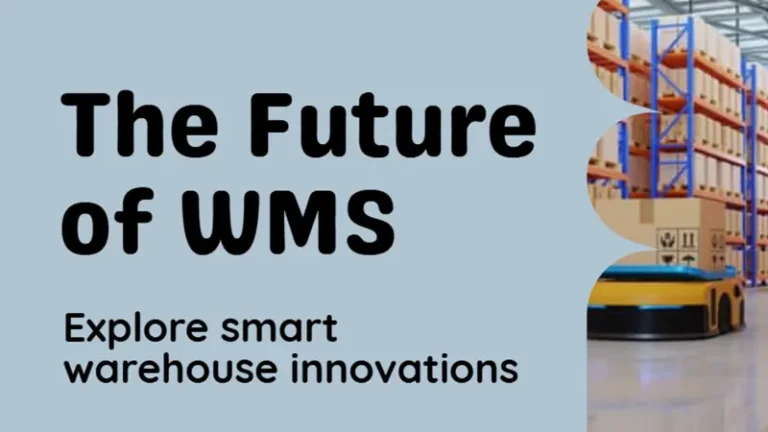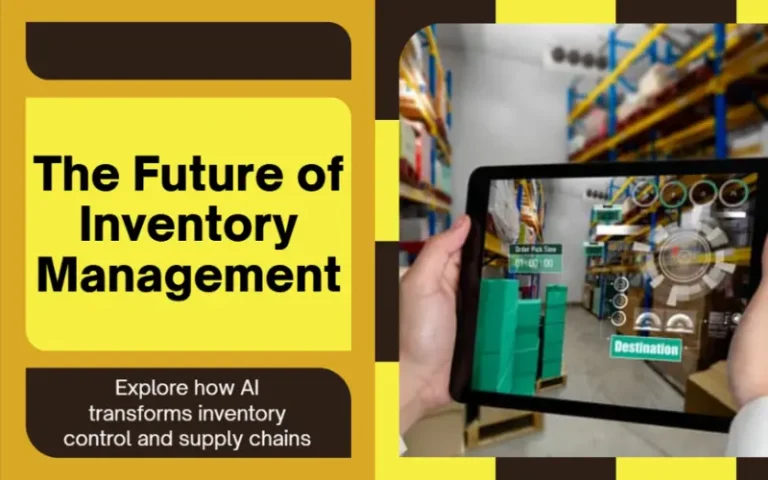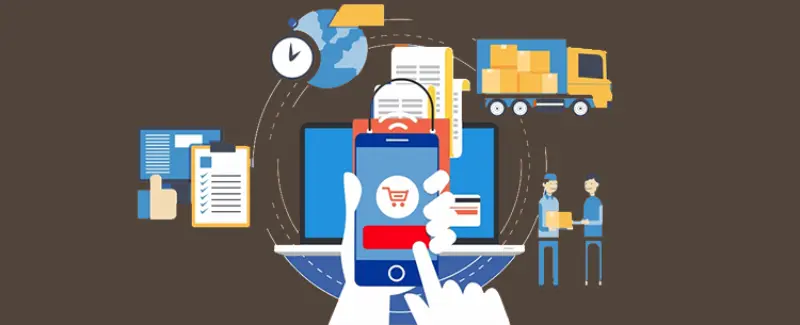10 Ways AI Agents are Transforming E-commerce Order and Inventory Management Systems
In this article
 100 minutes
100 minutes
Artificial Intelligence (AI) Agents represent a revolutionary leap in technological innovation and will transform business across every sector. They are intelligent systems that understand language and can perceive, analyze, and act upon complex data and/or workflows. “Act” is the key word. AI Agents take autonomous action on your behalf to complete the task or achieve the desired outcome.
The e-commerce industry stands to benefit enormously from this new technology because it’s a remarkably competitive and often low-margin business that unequivocally depends upon efficiency, accuracy, and adaptability for retailers and brands to be successful.
Slash Your Fulfillment Costs by Up to 30%
Cut shipping expenses by 30% and boost profit with Cahoot's AI-optimized fulfillment services and modern tech —no overheads and no humans required!
I'm Interested in Saving Time and MoneyUnlike conventional generative AI that generates outputs, (i.e. recommendations, and/or a plan), from “prompts” entered by a user (such as ChatGPT, Claude, etc.), AI agents self-reflect and learn from their interactions, continuously improving their performance without constant human intervention. AI agents can complete tasks that would normally require multiple tools and different activities, and you don’t need to be a developer to create and optimize them. For example, an AI agent (or agents, plural) could build and book a vacation within a given set of limitations. Think of all the steps (research and reviews, cross-references) that a human must perform to complete the same common task. The only thing to keep in mind is not to ask each agent to do too many different things. Keep each agent “in their lane” for optimal results.
- Always-On Customer Service
AI agents don’t sleep, take a lunch break, or have a bad day. While customer service may be the lowest-hanging fruit and most easily implemented on this list, AI agents are available when your customers need them, regardless of time zone, and they can answer most of your customer’s questions and resolve most of their issues. Most importantly, they can be configured to hand off to a human when they cannot resolve the inquiry or when the conversation otherwise reaches a point where the business may want to speak directly with the customer, such as discount or refund requests. But they can indeed be employed to create replacement orders, cancel subscriptions, and adjust auto-ship frequency, among other things. - Best-in-Class Demand Forecasting
Predict demand with remarkable accuracy to optimize procurement and avoid overstocking and stockouts. Traditional approaches are often plagued by unsophisticated data analysis methods leading to bad assumptions, and thus, poor procurement decisions. But modern Inventory Management Systems (IMSs) use AI agents to analyze massive amounts of historical sales data, read real-time news feeds to consider market trends and identify supply chain disruptions, track inventory movements, plus any number of other data points of interest, to make intelligent, real-time forecasts in the context of existing inventory available across internal and external fulfillment centers. - Autonomous [Humanless] Procurement
Building upon demand forecasting, AI agents can automatically create Purchase Orders with vendors at precisely the right time based on requirements such as minimum order quantity, and also based on defined guard rails such as total spend, current and future cash flow expectations, and vendor lead times for prep and transit. The best part is that it’s all based on natural language processing so if you can explain it, it can be done without complicated diagrams or wireframes. - Optimize Distributed Inventory Strategies
Minimize final mile shipping cost by staging inventory closer to your customers. Split inbounds across fulfillment centers based on the regional demand forecasting models described previously to optimize placement and minimize the cost of transferring inventory between locations later. Further, use the technology to track the inbounds and update ETAs for the team accordingly. Amazon’s been doing it for years. Now SMB retailers and brands can take advantage of the same technology. - Lowest Shipping Cost by Design
E-commerce retailers and brands traditionally have humans use their experience to ship orders, (primarily because legacy shipping software hasn’t innovated in over 10 years). But that approach is notoriously error-prone and costs the company a ton of money that should be kept as profit, even if it’s done at the manager level. Modern multi-carrier shipping software removes the human and creates the optimal shipping label that will deliver the order on time, every time. And now, combining that intelligence with AI agents, Order Management Systems (OMSs) can get even more granular and monitor weather conditions along shipping lanes, and then re-route orders to fulfillment centers that are more likely to deliver them by the promised delivery date, preventing customer service inquiries such as WISMO (Where Is My Order?) and refund requests. - Remove Waste from Fulfillment Workflows
Automate critical but rote tasks that would otherwise need to be completed by a human (e.g. creating shipping labels). Why does a human have to pick and click to print a label? Change your people from processors into analysts and put them on the tasks that will grow the business. - Supercharge Returns Programs
Returns are painful, but a necessary evil for any e-commerce operation. It’s critical to manage returns effectively (especially for the highest return rate categories such as women’s apparel). Groundbreaking new returns technologies such as the Cahoot Peer-to-Peer Returns Solution are already eliminating returns by enabling the return to be shipped directly to the next customer, saving significant money and time. Now add an AI agent that can predict the likelihood that the returned item will be sold in the next 7 days, and you’ve supercharged your returns program! - Optimize Warehouse Layouts
New technologies such as Synkrato’s Warehouse Optimization System (WOS) – powered by AI and Digital Twins are emerging to help merchants create a virtual warehouse that mimics their exact space, inventory positions, equipment storage, window and door positions, etc. which can be used to make changes in the virtual world and determine the impact of the change before going through all the work to find out that it wasn’t going to work. Optimize warehouse layouts, inventory storage, and more. - Dynamic Pricing Strategies
Unified commerce systems can leverage customer data including products viewed, dwell time, shopping cart contents, previously abandoned carts, purchase history, returns history, and demographic data in real time to create tailored shopping experiences that align with individual preferences. AI agents can monitor competitor pricing along with inventory levels and sell-through rates, read mass quantities of e-commerce news feeds to assess market demand and availability and make real-time pricing adjustments that convert the sale while maximizing profitability and remaining competitive. These personalized interactions not only drive sales but also foster loyalty. - Driving Business Insights with Advanced Analytics
Because AI agents can analyze enormous datasets quickly, and because most merchants have ‘dark data*’ that they don’t even know about, AI agents have access to many more insights and can identify many more trends than retailers can even think about asking for. At least currently. For example, Sellers can evaluate supplier performance at a micro-level comparing negotiated agreements and SLAs to actual performance and events and use the data to negotiate better terms.*Dark data refers to the unused portion of an organization’s information collected and stored during their regular business activities but fails to be used for analytics, advancing business relationships, or direct monetization. It’s not uncommon for as much as 50% of a company’s data to be dark.
Looking for a New 3PL? Start with this Free RFP Template
Cut weeks off your selection process. Avoid pitfalls. Get the only 3PL RFP checklist built for ecommerce brands, absolutely free.
Get My Free 3PL RFPSummary
The transformative potential of AI agents extends beyond mere automation rules and logic trees. AI agents are redefining how e-commerce businesses approach inventory and order management, transforming these processes from reactive tasks into strategic capabilities. By leveraging advanced technologies, these systems can dig deep into the dark data and deliver precise forecasting, intelligent automation, and actionable insights that enhance operational efficiency unlike ever before. They’re intentionally more specialized than generic generative AI such that the language that is used and the context that is understood within a particular industry or vertical, results in a more reliable and relatable assistant compared to the ChatGPTs and Claudes of the world.
As e-commerce businesses become more fluent in these new technologies and embrace these advancements, AI will transition from being a competitive advantage to a foundational necessity. Companies that integrate AI systems effectively will not only streamline their operations but also build the agility needed to thrive and position themselves for long-term success.

Turn Returns Into New Revenue
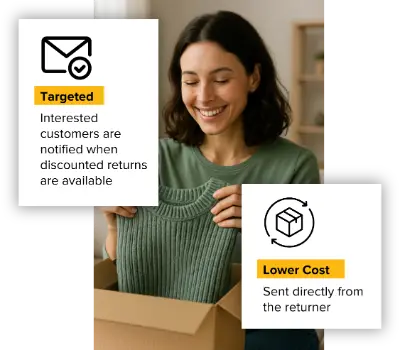
In-House or Outsource Fulfillment: What’s Best for Your eCommerce Business
The decision to outsource fulfillment to a third-party logistics (3PL) provider can be a strategic move for e-commerce businesses. 3PLs expand your fulfillment capacity and can even give you a hands-free approach to fulfilling orders. However, selecting the right partner and managing the relationship effectively can be challenging. Many sellers have reported problems with their 3PL ranging from same-day cut-offs, SLA issues, difficulty reaching support, and disruptive management changes.
What if outsourcing your fulfillment to a 3PL or doing fulfillment out of your warehouse doesn’t necessarily need to be a binary decision? Merchants have sometimes tapped into the best of both worlds by doing both. We’ll explore that in today’s article.
What is the benefit of working with a 3PL?
Outsourcing fulfillment to a 3PL can offer numerous advantages for e-commerce sellers. Firstly, 3PLs possess the expertise and infrastructure to handle the entire fulfillment process efficiently and cost-effectively. They have access to state-of-the-art warehouses, transportation networks, and experienced staff, allowing them to optimize operations and minimize errors. Their operations are set to do general e-commerce fulfillment well, this could be a big benefit for sellers new to fulfillment.
Secondly, partnering with a 3PL can provide businesses with greater scalability and flexibility. 3PLs can easily accommodate fluctuations in demand, ensuring that orders are processed and shipped promptly, even during peak seasons. Having multiple warehouses is especially important for meeting customers’ fast delivery expectations. This frees up e-commerce sellers to focus on other core aspects of their business, such as marketing, product development, and customer acquisition.
Slash Your Fulfillment Costs by Up to 30%
Cut shipping expenses by 30% and boost profit with Cahoot's AI-optimized fulfillment services and modern tech —no overheads and no humans required!
I'm Interested in Saving Time and MoneyThe Challenges of Choosing a 3PL
The benefits of working with a 3PL is not without its downsides. Selecting the ideal 3PL involves careful evaluation and due diligence. Businesses often encounter several challenges in this process:
- Hidden Fees and Overcharging: Many businesses report being surprised by unexpected charges or higher-than-expected costs. It’s essential to obtain detailed pricing information upfront and be wary of hidden fees. Make sure to estimate your total cost of ownership when getting quotes from a 3PL. Blindly comparing rates across many 3PLs can also be misleading as fulfillment fees (and other line items) can include different things at different providers.
- Inventory Inaccuracies: Ensuring accurate inventory management is crucial for avoiding stockouts and customer dissatisfaction. Some 3PLs struggle with maintaining precise inventory records and sellers have reported losing inventory as a result.
- Communication Breakdowns: Effective communication is vital for a successful 3PL partnership. Businesses often encounter challenges in reaching customer support, receiving timely responses, and understanding complex pricing structures. Large, established 3PLs may find it difficult to provide personalized attention, and it can be challenging to get in touch with someone who can fully resolve your problems, such as storage fee errors or missing inventory in transit.
- Lack of Flexibility: 3PLs may be unable to accommodate specific business needs, such as custom packaging or specialized handling requirements, or even reasonable cut-off times. For example, one merchant reported that their 3PL had an 8 AM same-day cutoff, which is unacceptable for any business offering fast delivery.
- Management Changes: While not frequent, changes in management at a 3PL can bring major disruptions. This risk should be considered when selecting a partner.
Why should you not work with a 3PL?
While outsourcing to a 3PL can offer benefits, managing fulfillment in-house also has its advantages and disadvantages:
Pros:
- Greater Control: In-house fulfillment provides businesses with more control over their operations, including inventory management, shipping, and order fulfillment processes. This allows for better oversight and the ability to address customer questions and concerns more effectively.
- Potential Cost Savings: For some businesses, managing fulfillment internally can be more cost-effective, especially for smaller operations or those with unique requirements. For example, we have seen merchants that generate less than $1 million in annual sales and sell items for less than $10 often find savings when doing fulfillment on their own rather than outsourcing.
Cons:
- Scalability Challenges: Scaling up operations can be difficult, especially during peak seasons or periods of rapid growth.
Looking for a New 3PL? Start with this Free RFP Template
Cut weeks off your selection process. Avoid pitfalls. Get the only 3PL RFP checklist built for ecommerce brands, absolutely free.
Get My Free 3PL RFPHow to minimize risk when working with a 3PL?
To mitigate risks and ensure a successful 3PL partnership, consider the following strategies:
- Thorough Due Diligence: Conduct comprehensive research and reference checks before selecting a 3PL. This includes evaluating their reputation, experience, and client testimonials.
- Regular Monitoring and Audits: Conduct regular audits to ensure that the 3PL is meeting performance expectations and complying with agreements. This can include ordering a package to yourself periodically to assess packing quality and identify any issues.
Consider a Hybrid Approach
Sometimes the best method is to use both in-house and outsourced fulfillment. If you already run a warehouse for your e-commerce fulfillment, outsourcing can be used for extra capacity for your popular goods. This way you limit the “risk” of a 3PL being unfamiliar with your items by sending just a small set of SKUs. Or you can use the 3PLs to power fast delivery programs like Amazon Seller Fulfilled Prime, which can then be leveraged to offer fast shipping on all channels.
The downside of doing a hybrid approach is additional complexity in determining which warehouse to ship an order as most popular shipping software today is designed for single warehouse fulfillment. To minimize this downside, you can use fulfillment networks like Cahoot that have integrated software and fulfillment service solutions built for hybrid models.
Scaling Made Easy: Calis Books’ Fulfillment Journey
Learn how Calis Books expanded nationwide, reduced errors, grew sales while cutting headcount, and saved BIG with Cahoot
See Scale JourneyConclusion
Choosing the right 3PL and managing the partnership effectively is crucial for e-commerce businesses. By understanding the challenges, evaluating the pros and cons of in-house fulfillment, and implementing strategies to overcome common issues, businesses can establish successful partnerships that drive growth and improve operational efficiency.

Turn Returns Into New Revenue

Build an Efficient Supply Chain: 5 Obstacles to Overcome
Ecommerce is experiencing an extreme, extended boom that is showing no signs of stopping.
Thanks in part to the pandemic, online shopping is now ubiquitous. As of 2022, 93.5% of internet users have purchased something online.
But as ecommerce grows and more and more sellers make the jump online, the pains of profitable scaling present themselves much clearer.
One of the biggest differences from physical retail that ecommerce businesses face is the way in which they organize their operations. Simply put, ecommerce order fulfillment is much more challenging and costly than replenishing retail shelves.
When selling to customers, delivering the product can be where the rubber meets the road for a seller’s profitability. While it seems like online shopping has been around forever, the fulfillment industry has taken longer to catch up with this new normal. Thankfully, there are now purpose-built solutions for ecommerce’s logistics challenges.
In this article, we look at the 5 most common fulfillment obstacles that ecommerce companies face and provide guidance on how to overcome them with modern tools.
Slash Your Fulfillment Costs by Up to 30%
Cut shipping expenses by 30% and boost profit with Cahoot's AI-optimized fulfillment services and modern tech —no overheads and no humans required!
I'm Interested in Saving Time and Money1. Unstable supply chain costs
The rising costs of oil and gasoline have headlined inflation troubles around the world. Few have felt the impact of these rising prices more than the logistics industry – and thus ecommerce sellers.
Fuel makes up a significant portion of the total cost of delivery operations, whether you use it for airplanes, cargo, or delivery vans. Faced with increased costs, fulfillment services are passing on the costs to their customers, ecommerce merchants. In the past few months, both Amazon and Walmart have added fuel surcharges to their prices for Fulfillment by Amazon and Walmart Fulfillment Services, eating into sellers’ margins.
The intuitive thing for a seller to do is to pass the cost on in turn to customers via shipping fees, but 55% of shoppers say they abandon a cart when the additional costs are too high. Price competition online is brutal thanks to how easy it is to find competing products, so sellers have been left battling ever-narrowing margins.
In the short term, a workaround would be to work your delivery fee — or a portion of it — into your product pricing so buyers don’t feel it as much. Another option would be to offer bulk orders at a discount so they can save money when they buy more in one go.
These short-term solutions leave you vulnerable to being undercut by the competition, though. The only lasting solution to rising logistics costs is to adopt a fundamentally lower-cost model. You need to store your inventory close to customers across the country, so that no matter where an order is placed, it can be delivered to them quickly and efficiently via ground shipping. Modern fulfillment networks like Cahoot are designed with ecommerce in mind and will strategically distribute your inventory across the country, lowering your shipping costs to the minimum possible.
2. Changing customer purchasing behavior
Another of the more common ecommerce fulfillment challenges isn’t in the industry itself but in the end users. People’s behaviors are changing.
For one, payment behaviors are rapidly shifting due to innovation in online payments. Whereas people once paid primarily through credit cards, many buyers are turning to e-wallets. This has had a bigger-than-anticipated effect on conversion for online merchants, many of whom are observing their cart abandonment rates edge upwards without the options that people want.
The straightforward solution for ecommerce businesses is to have multiple payment channels on your website. Provide at least three options for your customers to choose which payment channel works best for them.
The three payment options you should have at the bare minimum are credit card, debit card, and e-wallet. If you want to go further, there are now online payment tools that aggregate many more than three options and enable all of them at once on your site. Consumers can pick their favored option (usually one that already has their information saved) and quickly check out. In this way, the right checkout option can boost your conversion.
Looking for a New 3PL? Start with this Free RFP Template
Cut weeks off your selection process. Avoid pitfalls. Get the only 3PL RFP checklist built for ecommerce brands, absolutely free.
Get My Free 3PL RFP3. Poor product handling across the supply chain
You must know the pains and headaches of dealing with a damaged or expired product, either as a buyer or a seller. Poor delivery experiences are devastating to an ecommerce sellers’ profitability. The hit comes in three places – one, you have to process a return. Two, you have to send a new item and write down the damaged one. And third, you likely will lose the customer! Most sellers lose money to convert new customers, and then build a profitable business through repeat purchases. Damaged products threaten lost customers and a severe hit to the bottom line.
While some delivery damages happen due to carrier negligence and cannot be avoided, a lot of them can be mitigated or minimized with smart fulfillment strategies. Third party logistics (3PL) companies that don’t specialize in ecommerce likely don’t know what it takes to safely package a product to be sent to a customer. If the 3PL company has been around for a long time and grew through retail replenishment, they’re used to shipping in bulk. On the other hand, warehousing services that are build specifically for ecommerce know how to store and pack single products ordered online to minimize damage.
Using manual and automated inventory management systems, warehousing partners can track notes on certain inventory so they know how to handle them best and avoid any food spoilage because of wrong room temperatures and other storage conditions. Inventory management solutions make it easier for warehousing staff to track handling concerns and requests. The added edge of automated inventory management will help avoid any unwanted damages to the products such as breakage, spoilage, and so on.
4. Rider and delivery crew reliability
With the growth of just-in-time last-mile services, there have been growing challenges to manage that part of the fulfillment process. Restaurants face various last-mile delivery challenges, but one of the most common has to be rider reliability. While many riders remain reliable and competent, there will always be a bad bunch that stain the reputation of a business and its merchants.
Using some form of feedback system to gather insights into rider performance is crucial in this sense. Companies, whether the riders or the merchants, should also use these systems to evaluate whether they should work with a certain rider or not. For instance, if you have a rider that has a star rating lower than three, then it should be a signal for a last-mile delivery company, merchant, or customer to not do any business with that service provider.
5. Lack of efficient supply chain processes
As author of Atomic Habits James Clear once stated, “You do not rise to the level of your goals. You fall to the level of your systems.”
That principle doesn’t just apply to personal productivity. It applies to business efficiency too. A fulfillment and delivery operation must have systems and processes that are optimized for the task at hand. This extends to your fulfillment provider, who must be optimized for ecommerce, and to you and the way in which you communicate with your customer after they’ve placed an order.
For example, giving timelines on your delivery should be a part of your system. Currently, 24% of online buyers will abandon an order if no delivery date is provided. Amazon set the standard for “date certain” delivery, as it’s called, and now it’s an expectation that all online sellers must meet. You should be able to supply that information with an order tracking system to remove the buyer anxiety most people who order online might feel.
Of course, date certain delivery won’t be a positive experience for your customers if the date they see is more than a week in the future, or if they had to pay an arm and a leg for shipping. This is where your fulfillment provider also must be optimized for the world of modern ecommerce. As we mentioned before, if they haven’t built a network that blankets the country in warehouses, and if they don’t have intelligent software that can govern where each order should ship from, they simply can’t support your needs. You need fast shipping at a low cost to compete – and anything other than a nationwide network of ecommerce warehouses can’t do that for you.
Scaling Made Easy: Calis Books’ Fulfillment Journey
Learn how Calis Books expanded nationwide, reduced errors, grew sales while cutting headcount, and saved BIG with Cahoot
See Scale JourneyFulfillment defines efficient ecommerce supply chains
Learning how to solve fulfillment challenges is crucial for any ecommerce business. As the world of online buying and selling grows, your options for cutting-edge ecommerce fulfillment operations expand as well. You don’t need to operate your own warehouses to win. Even small to medium businesses can make the world their oyster and sell everywhere if they pick the right fulfillment provider that will help them win new customers and keep their costs low.
Cahoot’s nationwide network of over twenty warehouses provides affordable national ecommerce order fulfillment for online merchants. Thier wide and diverse network enables them to fulfill a wide variety of needs, from sellers who need absolute peak speed at minimum cost to those that have fragile items or others that require special handling.
Their fulfillment centers are outfitted with dedicated personnel and technology that creates an efficient supply chain:
- Efficient picking enables late 2pm order cutoffs
- Barcode scanning all but eliminates incorrect orders
- Intelligent pick and pack software optimizes boxes for every order, minimizing shipping cost for complex orders
- Lowest cost by design
Getting started with Cahoot is fast and easy – with pre-built integrations for major ecommerce channels like Amazon, Walmart, Shopify, and BigCommerce, they can get merchants started in as little time as it takes to send us your inventory.
Talk to one of their experts today and explore how we can be the key that unlocks the next level of your profitable ecommerce growth.

Turn Returns Into New Revenue

Pulse Commerce Recognized by Forrester in 2021 Omnichannel OMS Report
In this article
 2 minutes
2 minutes
2/18/2021
BRIDGEPORT, CT—Pulse Commerce, a leading Omnichannel Order Management System and Inventory Platform, today announced that it has been recognized in Forrester’s Now Tech: Omnichannel Order Management Systems, Q1 2021 report. The report provides an overview of 30 Omnichannel OMS providers across various sizes and geographies.
“We are very excited to be featured in this list of 30 leading providers for OMS”, said Manish Chowdhary, founder and CEO of Pulse Commerce. Pulse Commerce combines OMS with optional components that power eCommerce from end-to-end, including Inventory & Fulfillment Management, Ecommerce Platform, CRM, and POS. Retailers can take advantage of the full Pulse Commerce suite or use it alongside their existing services using our rich and mature integrations.
According to Forrester, OMS provides enterprise-level inventory visibility and distributed order management (DOM), customer order management, and store fulfillment. All of which became more relevant as COVID-19 changed customer behaviors dramatically and eCommerce flourished in 2020.
The spike in order volumes from COVID can lead to a sharp increase in “Where is my order” calls from anxious customers. But Pulse Commerce retailers have proactive shipping notifications that inform retailers of any shipping issues like failed delivery attempts, late deliveries, or weather related delays. So, they can inform customers of any potential delays or issues before customers get restless, turning a potentially bad experience into a loyalty-boosting event. Learn more about building customer loyalty from our in-depth article here.
Since 2020, Pulse Commerce also integrates with Cahoot, an ecommerce order fulfillment network that allows brands and retailers to offer 1-day and 2-day delivery. With Cahoot, merchants can distribute their inventory closer to customers and deliver orders within 1-day or 2-days using inexpensive ground shipping.
Find out how Pulse Commerce makes commerce simple through our no-commitment demo.
About Pulse Commerce
Pulse Commerce is the leading cloud platform for enterprise order & inventory management, empowering retail leaders with unprecedented visibility and control of inventory, orders, and customers. Retailers rely on Pulse Commerce to improve order turnaround, increase customer satisfaction, and optimize inventory control and fulfillment costs.
About Forrester
Forrester Research (Nasdaq: FORR) is one of the most influential research and advisory firms in the world. We work with business and technology leaders to develop customer-obsessed strategies that drive growth. Through proprietary research, data, custom consulting, exclusive executive peer groups, and events, the Forrester experience is about a singular and powerful purpose: to challenge the thinking of our clients to help them lead change in their organizations. For more information, visit forrester.com.

Turn Returns Into New Revenue

3 Strategies to Fulfill Like Amazon
If Amazon reduced shipping costs by just 1 percent, it would save $162 million. Amazon spent $16.2 billion on shipping in 2016. We can be certain that it is spending millions to improve and optimize its shipping processes. Ecommerce merchants can take advantage of Amazon’s efforts to increase profits.
Amazon’s 2016 shipping expense was 17.7 percent of direct ecommerce revenue. That’s $8.85 for every $50 order, which is achievable by most merchants.
This post, describes three strategies to fulfill like Amazon, even if you have a fraction of its scale and infrastructure
- Manage Carriers
- Manage Yourself
- More Choices, Urgency
Manage Carriers
Manage carrier contracts by the numbers. Negotiate better rates using data and analytics.
Analyze accessorial charges. These are extra fees assessed on top of the base rate. Compare every accessorial line item, by carrier, as a percentage of total shipping costs.
- Errors, such as address correction, return charge, and incorrect weight.
- Extra services, such as residential or rural delivery, remote area delivery, and Saturday delivery.
- Surcharges, including fuel charges, hazardous materials and international dangerous goods, and holiday season surcharges.
Analyze standard shipping fees for each cost driver.
- Distance, weight, volume.
- Size to weight ratio — e.g., dimensional weight surcharges for light (but big) items.
- Service level — e.g., next day air versus 5-day ground.
Negotiate like a pro.
- Focus on the accessorial fees that have hit you the hardest.
- Negotiate shipping fees with each carrier to match the lowest priced carrier for each category.
- Negotiate insurance fees with each carrier as well as with pure-play insurers.
Enforce each carrier’s service level agreement and negotiated prices.
- Validate that carrier bills are indeed reflecting your negotiated prices.
- File timely reimbursement claims for SLA violations — within 15 days, typically.
Automate intelligent carrier and service selection. In my experience, companies can save up to 25 percent on shipping costs from this strategy alone. No single carrier offers the best rates for every situation. The carrier that charges the least for an in-zone ground shipment may not be the one that charges the least for a 2-pound next day air delivery.
Create decision rules for choosing carriers and service types based on factors such as dimensional weight and delivery zone. Rather than attempting to cover every possibility, start by implementing the rules for 80 percent of your orders. Make sure to meet the minimum volume that you promised a carrier to secure your discounts and negotiated rates.
Implement these intelligent rules across all fulfillment centers and drop-ship vendors and then automate the selection process for your entire order management and warehouse management systems. Here are two examples.
- Geography-based rules. Shipper A charges the least for shipments from New York to Arizona while Shipper B charges the least for same-zone shipments.
- Weight-based rules. Shipper C charges the least for next-day air packages under two pounds.
Slash Your Fulfillment Costs by Up to 30%
Cut shipping expenses by 30% and boost profit with Cahoot's AI-optimized fulfillment services and modern tech —no overheads and no humans required!
I'm Interested in Saving Time and MoneyManage Yourself
Like Amazon, audit and analyze your own operations routinely to deliver orders faster and cheaper. This may seem obvious, but many mid-market retailers lack the technology and infrastructure. Your ecommerce systems should facilitate automated rules, in addition to answering the following questions:
- Which products are generating the highest discrepancies between the shipping fee invoiced to the customer versus what’s charged by the carrier?
- What is the best carrier for each product, order size, and geography?
- Which shipments resulted in missed carrier SLAs or actionable exceptions?
Eliminate costly errors. Accessorial charges are typically the result of errors. According to Refund Logistics, 31 percent of carriers’ invoices include these extra fees, on average. Common errors and resulting fees include:
- Incorrect address, resulting in address correction and return fees.
- Incorrect dimensions and weight, resulting in DIM charges, which can be eliminated by ensuring product catalog data is accurate.
Intelligent order routing. Route orders to the fulfillment center(s) closest to the customer.
- Ship faster and reduce shipping costs up to 25 percent.
- Pick the least expensive shipping type that gets the package to its destination within the promised delivery date commitment.
Go omnichannel. If you’re an ecommerce merchant with physical stores, leverage those stores as fulfillment centers.
- Ship from store. Shipping from stores can reduce shipping costs and speed up delivery. For example, Best Buy reduced average shipping time by two days with its ship from store program. Revenue may increase, too, with this strategy. American Apparel reported a 30 percent increase in sales from using stores as backup fulfillment centers.
- Buy online, pick up in-store. Offer pickup in-store as a delivery option for online customers. It eliminates shipping fees and increases customer satisfaction. Plus, customers spend an additional 20 percent, on average, when picking up their items.
Looking for a New 3PL? Start with this Free RFP Template
Cut weeks off your selection process. Avoid pitfalls. Get the only 3PL RFP checklist built for ecommerce brands, absolutely free.
Get My Free 3PL RFPMore Choices, Urgency
Offer more choices. Increase conversions by giving customers delivery options that provide greater certainty of delivery times. For example, Amazon offers these shipping choices:
- “Tuesday, Sept. 12: $5.99 One-Day Shipping.”
- “Wednesday, Sept. 13: Free Two-Day Shipping.”
- “Friday, Sept. 15: Free No-Rush Shipping + Get $5 Reward for Prime Pantry.”
Create urgency to increase conversions. On your product details, shopping cart, and checkout screens, show how much time is remaining to complete the order and still receive guaranteed delivery by the desired date.
If you are already implementing these techniques and are looking for more tips and tricks, check out this comprehensive guide to profitable free shipping

Turn Returns Into New Revenue

The Definitive Guide to Distributed Order Management System
In this article
 19 minutes
19 minutes
- I. Introduction
- II. The New Ecommerce and Retail Realities in the Age of Amazon Prime
- III. What is Distributed Order Management?
- IV. Distributed Order Management System Capabilities
- V. Omnichannel Commerce and Distributed Order Management – A Match Made in Heaven
- VI. Distributed Order Management Software Deployment Models
- VII. Distributed Order Management System Software Vendor Selection
- VIII. How to Calculate the ROI on Order Management Systems
- IX. Tips for Successful Distributed Order Management System Implementation
- X. Conclusion
I. Introduction
Almost every “next year’s retail trends” article includes omnichannel commerce as one of the potential saviors of non-Amazon retail as we know it. The conventional knowledge is that multichannel merchants’ only chance of surviving is to take advantage of their biggest assets, their stores, to deliver services that Amazon cannot. By combining the power of their stores and their ecommerce websites they can create a retail whole greater than the sum of its parts.
How can siloed commerce systems and processes transform into a unified platform — one that can deliver on the promise of omnichannel commerce? BPR’s Ken Morris’ perspective is that, “Retailers aren’t going to throw their legacy applications away, they’re not going to throw their investments away, but what they have to do is link it all in real time.” The solution: “The most important component is a middleware layer—a piece of software that connects the dots.”
Distributed Order Management System (DOM) is that middleware. Distributed Order Management is the unsung hero of omnichannel Retail Commerce, a hero rarely mentioned in articles about buy online pickup in store.
Continue reading to learn why distributed order management systems have taken on such an important role in retail innovation, and the practical implications for your business.
II. The New Ecommerce and Retail Realities in the Age of Amazon Prime
Amazon generated over 25% of all U.S. Retail growth in 2016[1], and their sales represented 5% – 6% of total U.S. retail sales. This one behemoth pushed all others aside to eat an outsized chunk of retail pie growth. Many analysts consider Amazon Prime to be a significant growth driver, with over 90mm Prime members[2] who have access to movies, e-books and photo storage, at no additional charge. Of course, free 2-day shipping is included too.
For perspective, at $99 per year, that’s $9B in Prime Membership revenue, before a single purchase is made on the site. Collectively, consumers with Prime Memberships have a $9b incentive to purchase on Amazon to take advantage of 2-day free shipping. The psychological pull is strong — “Why should I try to meet the $75 free shipping minimum on otherwebsite.com when I already have free shipping on Amazon?”
The new ecommerce realities are margin eaters. Over 90 million Prime consumers expect:
- Free and fast shipping options
- Date-certain delivery choices (Amazon typically offers 4 options)
- Frequent, accurate, multi-device order status updates (website, mobile, text)
- Frictionless returns
- Lower prices, with multiple merchants offering the same products on Amazon Marketplace
As a result merchants face new challenges. How can you capture your fair share of ecommerce growth, while also:
- Adding free shipping and multiple, date-certain delivery choices
- Providing frequent, accurate, order updates
- Offering simple returns and exchanges processes
- Holding prices in check
Meanwhile, many pure play ecommerce businesses are far more complex today than they were 15 years ago. The days of a single ecommerce storefront are long gone, with many pure-play ecommerce merchants also selling through marketplaces, including Amazon, to ride the coattails of their huge traffic. In terms of sourcing, merchants purchase from multiple vendors, and they’re also selling products fulfilled by drop-shippers.
Multichannel retailers with bricks and mortar storefronts entered the ecommerce fray quite a while ago. Their challenges are even more daunting. Sales channels no longer operate in silos. Many are seeking to offer omnichannel services that pure play ecommerce player like Amazon cannot (until recently). Buy online and pickup in the store; buy online and return to the store; inventory optimization across stores, ecommerce storefronts, and warehouses; persistent shopping carts that remain current as consumers move from the website to the mobile device to the store; ship from store. The list is growing.
The new reality is that the companies who are capable of creating omnichannel experiences for customers, to differentiate versus Amazon, are most likely the ones who will come out ahead in the retail shakeout currently underway. The merchants that consistently deliver stellar and consistent service as consumers shop across channels, and transform their sales channel silos into an integrated whole will be the winners.
[1] https://www.digitalcommerce360.com/2017/02/17/us-e-commerce-sales-grow-156-2016/
[2] http://www.businessinsider.com/amazon-prime-subscribers-chart-2017-10
III. What is Distributed Order Management?
We’ll define Distributed Order Management by first defining Order Management in the context of a simple ecommerce business with an online storefront and a single fulfillment center.
Order Management is the capture and processing of a customer order, followed by the assignment of that order to a fulfillment center or 3PL to pack and ship the item(s). Order management also includes reverse logistics (returns). In this simple case, there is only one location receiving returns, so tracking is straightforward, as is adding the item back into inventory.
Distributed Order Management (DOM) was born out of challenges that arose as ecommerce grew more complex. A DOM addresses the challenges that channel proliferation and rising expectations introduced. Many online-only businesses now sell through multiple channels – their own storefronts plus multiple marketplaces. Sourcing and fulfillment are more complex too, with products fulfilled by multiple warehouses, dropshippers, and 3PL’s.
New challenges are plentiful:
Challenge #1: With multiple sales channels, how do you ensure you only sells items that are in stock?
How does the ecommerce storefront evaluate whether an item in the shopping cart is still in stock? If the last item is sold through your storefront, will your marketplace stop selling the item? Or continue selling?
Challenge #2: How do you decide which fulfillment center should handle an order?
With orders coming in from multiple storefronts, and being distributed to multiple fulfillment centers, a new question emerges. Should you ship from the fulfillment center closest to the ship-to-address? Or to the fulfillment center with the highest days of inventory on hand? How will you handle an order that includes 2 items that are not in the same warehouse? What about an item that is out of stock, but on its way to the warehouse?
Challenge #3: Which carrier should be used to ship faster and cheaper?
Even with Amazon’s economies of scale, shipping costs were over 17% as a percent of their average order value in 2016. To keep shipping costs in check, which carrier should you use for a specific delivery — e.g. which one has the best price for 2-day guaranteed delivery from North Carolina to Texas?
Challenge #4 (and 5 and 6): Bricks and Mortar
Now add brick-and-mortar storefronts into the mix. How can you keep a real-time holistic pulse on inventory with orders coming in from online sources and items also being sold in stores? How can you squeeze synergy out of bricks and clicks? How can your store associates accept a return for an item purchased online? Will it be reflected in inventory? If an item is out of stock in your fulfillment center, can you sell it online and ship from a store? The questions, challenges and opportunities are endless.
Taking these questions a step further, If a retailer intends to deliver consistent experiences across all channels, and to put all of their inventory to work (e.g. an online order can be shipped from a store), complexity increases exponentially. Silo’d systems can’t possibly keep up.
A Distributed Order Management System processes orders from multiple sales channels and intelligently routes them to the ideal fulfillment center. Some can even select the ideal shipper, too. Orders are turned around faster and more accurately; inventory turns increase; shipping costs decrease. Implemented properly, the Order Management System squeezes more out of your prior commerce technology investments, unifying them to orchestrate streamlined operations, optimized inventory, faster order turnaround, and better cross-channel customer support.
IV. Distributed Order Management System Capabilities
An order management system resolves the challenges outlined above by:
- Synchronizing real time Order and Inventory data with all sales channels and fulfillment centers
- Processing orders from multiple sales channels (e.g. fraud checks, payment processing, address correction)
- Calculating the optimal fulfillment location based on priorities (e.g. closest to customer; fulfillment center with highest inventory)
- Routing the order to the ideal fulfillment center and maintaining up-to-date inventory information.
The distributed order management system also does far more. It not only routes the order, it prioritizes fulfillment of each order against the others, and manages back-orders and reservations for pre-launch products.
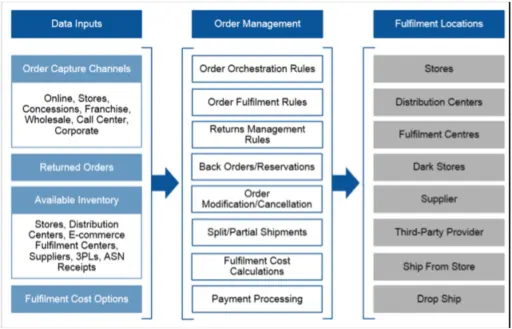
Source: Gartner Market Guide for Retail Distributed Order Management Systems, 2017
Capabilities include:
- Single data repository of all orders and all inventory from all retail channels and fulfillment centers, providing real-time inventory to POS, fulfillment, and ecommerce platforms. An enterprise DOM will also house customer order histories, and product and pricing information.
- Order acceptance from multiple sales channels, including marketplaces.
- Payment processing and checkout, including credit checks, fraud checks, payment authorization, tax and export duty calculations, and refund payment processing.
- Order routing to the ideal fulfillment center or dropshipper based on customized rules and priorities, to optimize inventory turns, or reduce shipping costs and delivery times. Typically integrated with shipping carriers, the DOM can select the ideal carrier for the order.
- Order modification or cancellation via any channel (online, store, contact center) prior to shipping.
- Order tracking and lead-time estimates throughout the entire order lifecycle.
- Omnichannel service enablement for buy online pickup in store, buy online return to store, ship from store, and ship to store services
- Sophisticated handling of pre-orders, back-orders, and order splitting. For example, routing pre-orders and backorders to fulfillment as soon as inventory is available.
An enterprise strength DOM also manages product information across multiple sales channels and includes business analytics tools and reporting to make maximum use of the DOM’s robust order and inventory data.
The power of these capabilities is immense. Consider some real-life shopping situations.
A shopper is in a fashion retail store, and the store doesn’t have the blouse in stock in her size.
Without a DOM, she will leave empty handed. At best, a high-touch store associate can call around to other stores to find one with the item in stock. These calls take time, and may be fruitless. With a DOM, they have real-time access to inventory availability across the entire enterprise. A store associate can rapidly order online for in store pickup, order online for delivery to the customer, or have the item shipped from another store to the customer.
A consumer needs to buy a specific item tonight, and wants to make sure the item is in stock first.
Without a DOM, it’s not possible for the ecommerce site to display store product availability. The information sits in silos. If he’s shopping on REI.com, he’ll find out the closest store with the item in stock, and will be given the option to buy online and pickup in the store. The ecommerce website reveals real-time inventory across every store. Each store’s POS is linked to the DOM, updating inventory every time the cash register rings.
A consumer buys online and wants to modify the order before it has shipped.
Without an Order Management System, once the order is sent to a fulfillment center, there is no turning back. It’s in a queue to ship. The consumer will have to wait for it to ship, and to be delivered, in order to exchange it. With a DOM, the consumer can modify the order in the store, via the contact center, or on the ecommerce website. Each has order-level data, with up-to-date fulfillment information, and the ability to change the order and update all of the systems touching the order.
Behind the scenes, a DOM’s impact on inventory turnover can be profound too. A 5% reduction in out of stocks and a 5% reduction in overstock situations can move a merchant from being in the red to in the black — especially during the holidays! The DOM accomplishes this by intelligently routing orders to optimize inventory across every fulfillment center, retail location, and ecommerce website.
V. Omnichannel Commerce and Distributed Order Management – A Match Made in Heaven
To see why Omnichannel Commerce and Distributed Order Management make such a wonderful couple, it’s worth taking the time to understand some related terms.
Multichannel Retail is exactly what it sounds like. For example, a retailer may sell through a handful of brick-and mortar stores, an ecommerce storefront, and Amazon marketplace. Whether the channels act as silos or are integrated, the term multichannel refers to selling products through multiple sales channels. These channels can operate in distinct silos from end-to-end. E.g. different warehouses for online versus stores.
Omnichannel Commerce refers to seamless, consistent, effortless, integrated customer experiences for shoppers as they traverse different sales and support channels. Shoppers enjoying a stellar omnichannel experience feel like, regardless of sales channel, that they’re interacting with a single company that sees them as one individual — whether on the website, in a store, or on the phone with a contact center rep, the shopper sees one company. For example, customers may have a single, persistent shopping cart on the website, their mobile device, and even on in-store tablets (e.g. Crate & Barrel’s wedding registry). Or a customer may buy online and wish to return to a store. Or a shopper may buy online, and make an exchange in-store before the item has even shipped. At every step, the store associate, contact center rep, and website have the necessary information and processes at their fingertips to serve the customer with knowledge of their past interactions.
How can a merchant make this happen? How can a store associate modify an online order? When they do, how will the fulfillment center be informed not to ship? How will inventory be tracked across all channels? Distributed Order Management.
Omnichannel Commerce and the Distributed Order Management System is a match made in heaven. A DOM enables Omnichannel Commerce to flourish. Without demand for omnichannel commerce, a DOM’s purpose in life would be far diminished.
VI. Distributed Order Management Software Deployment Models
An Order Management System can unify existing, siloed, commerce technology to unleash a commerce whole greater that the sum of its technology parts. Deep business significance is hidden between these buzzwords. Most merchants did not start out as multi-channel businesses. An online only store might have, over time, decided to sell through marketplaces. Or, a brick and mortar chain may have decided to begin selling online. Growth-minded merchants find, at some point, that technology that worked so well when they served only one channel is not up to the complex tasks of breaking down business silos.
A Unified Commerce Platform integrates the commerce technology stack to enable these complex transactions. A Distributed Order Management system is the catalyst that transforms existing, siloed technology into a Unified Commerce Platform.
If you’re planning to implement a robust order management system, what is the best approach? For a comprehensive overview, see our blog post and whitepaper, “Which OMS is Best for Me? Home Grown, On-Premise, or SaaS?” Given today’s technology trends, start with the assumption that a cloud-based solution is probably the best choice, because you’ll avoid the headaches of running a data center, updating software, managing compliance, and other distractions from your core expertise. Answering a handful of questions can help a mid-market merchant decide which approach is best for their business:
Question 1: Does your business have a state of the art data center? If not, then there’s little point in considering anything other than SaaS. With increasing security concerns, especially in ecommerce, the risks are simply too high to run your commerce technology on anything less than a top-notch data center.
Question 2: Does your business have truly unique needs that would require customization? If so, are these unique needs due to the nature of your legacy systems? If you’re customizing to put a bandaid on old technology, then it’s time to update the house of cards rather than add more complexity. If you truly do need customization, then a premise-based solution will offer greater customization capabilities.
Question 3: Are your customization needs so vast that even a premise-based solution can’t meet your needs? Are you considering building instead of buying? If so, then you should only consider going forward if software development is a core strength and differentiator for your company. If not, then you’re heading down a treacherous path building a homegrown solution.
VII. Distributed Order Management System Software Vendor Selection
The most important step in selecting an Order Management System is to very clearly identify all of your requirements. You can find a comprehensive overview of potential features in our Order Management System RFP Template. You can also find an overview requirements often missed until it’s too late in, 5 Hidden Costs to Avoid when Buying an OMS. Following is just a sampling of the kinds of requirements you may not have considered without some prompting.
Distributed Order Management: Do you need purchase order support for B2B ecommerce? Do we want to enable customers to choose their delivery date? Do we intend to enable customers to set up recurring orders (e.g. subscribe and save)? Do we need to integrate drop shipping into our OMS?
Inventory Management: Do you need to track inventory across multiple sales channels and fulfillment centers? Do you need the OMS to create vendor purchase orders? In bulk? Do we intend to use store inventory for ship-from-store and buy online, pickup in store services?
Customer Service: Do CSRs need to be able to search all orders across channels? Do you intend to empower CSRs to modify website orders? Do you want CSRs to issue refunds and credits?
Stores and Fulfillment: Do you want to customize shipping criteria or carrier by SKU or delivery location? Do you intend to support for buy online pickup in store / return to store?
Other Systems: With which systems must the DOM integrate?
If this is your first DOM procurement, the requirements phase is absolutely critical. Even our list of over 150 features (see above) doesn’t cover everything one might need.
With a clear view of your needs and their relative importance, comparing and selecting vendors becomes a typical procurement exercise. Just never take your vendor’s word for their depth of capabilities. Make sure you see all of it in action.
VIII. How to Calculate the ROI on Order Management Systems
The Return on Investment for Order Management Software is gained through a combination of efficiency gains that reduce costs and free up cash.
Inventory Optimization
A DOM pulls a number of levers to increase top line revenue (fewer stockouts) and increase inventory turns (less overstock). Enterprise-wide visibility reduces need for “just in case” inventory while Intelligent Order Routing reduces “slow inventory.” The ability to “ship from store” enables you to fulfill orders when your warehouse is out of stock. All of these improvements reduce the inventory needed to run the business, freeing up cash and saving on warehouse costs (i.e. fewer square feet needed).
Return = Reduction in average inventory x Line of Credit Interest Rate
Fulfillment Efficiency
The DOM routes orders near-instantaneously to the optimal fulfillment center. The routing includes accurate packing slips and shipping labels (i.e. employee proof). Error reduction is a hard cost saving, with less return shipping, customer support hours, and reverse logistics management.
Return = Reduction in return shipping expense + reduction in reverse fulfillment labor costs + reduction in returns-related customer service call labor expense
Employee Efficiency
The DOM assigns orders for more efficient fulfillment, including packing slips and shipping labels, shedding some man hours. Contact center reps benefit handsomely, with the ability to see all orders, inventory, shipping status and customer order history with one login. Issue resolution time can be cut dramatically.
Return = reduction in issue resolution time x CSR pay rate
Pulse Commerce’s OMS ROI Calculator calculates these potential profit impacts, based on your own inputs and assumptions.
IX. Tips for Successful Distributed Order Management System Implementation
The success of your deployment, or lack thereof, can be the difference between a high ROI investment and a negative one. The most important component of a successful implementation is your requirements gathering effort during procurement. In general, the success of a SaaS implementation is driven by three factors:
(1a) Did you seek all of the capabilities you’ll need (see above)?
(1b) Does the software do all that you were told it does? This includes performance, latency and uptime, too.
(2) Does the OMS integrate well with your existing commerce technology?
A successful deployment rests on the OMS’ API’s. Robust and well-documented APIs, bode well for the implementation. If custom API’s are needed, then you may be on track for project overruns — in both time and money.
(3) Is vendor technical support a partner? Or an adversary? Will you spend more time convincing tech support to help? Or more time getting help? This is one of the most important areas to pressure test with customer references.
X. Conclusion
At its core, omnichannel commerce is just a fancy way of saying, “treat customers as they’d expect you to if everyone in your company and all of your systems knew every interaction you’ve ever had. All while allowing customers to treat all sales channels and touchpoints as one, single entity. As customers go from Pinterest to your website, to your store, it all feels like one seamless shopping experience. A Distributed Order Management System is that centralized memory and up-to-date repository of these insights. It’s also the conductor of the modern retail commerce orchestra — a conductor that appears to be on the verge of fame.

Turn Returns Into New Revenue

Leading Industry Analyst Forrester Adds Pulse Commerce to Omnichannel OMS Report
In this article
 1 minute
1 minute
Pulse Commerce has been included in the “Now Tech: Omnichannel Order Management Systems, Q2 2018” report by a leading industry analyst. The report can be utilized by retailers to select from a diverse set of vendors and understand the value they can expect from an omnichannel OMS provider. We are very excited to be a part of this chosen list of vendors.
Per Forrester – You can use an omnichannel order management system (OMS) to provide enterprise-level inventory visibility and distributed order management, customer order management, and store fulfillment. But to access these benefits, you’ll first have to select from a diverse set of vendors — vendors that vary by size, target market, geography, and vertical market focus. Digital business pros should use Forrester’s Now Tech report to understand the value they can expect from an omnichannel OMS provider and select vendors based on size and target market.

Turn Returns Into New Revenue

Sure Fit Home Décor Selects Pulse Commerce and Shopify Plus to Power its Commerce Operations
Shopify Plus Ecommerce Platform and Pulse Commerce Order Management System to Power Sure Fit’s Next-Gen Omnichannel Commerce
Bridgeport, CT, December 5, 2017 – Sure Fit, Inc. announced today that they have selected Shopify Plus and Pulse Commerce Order Management System (OMS) to jointly power its next-generation omnichannel commerce platform.
Founded in 1914, Sure Fit Inc. is the nation’s most trusted provider of easily-installed furniture covers, slipcovers and decorative accessories. Their products have been sold through leading retailers, such as Macy’s, Target, and Walmart, for decades. As their retailers have moved online, Sure Fit has stood beside them, selling through their retailers’ websites as well as their own homegrown flagship ecommerce website.
Slash Your Fulfillment Costs by Up to 30%
Cut shipping expenses by 30% and boost profit with Cahoot's AI-optimized fulfillment services and modern tech —no overheads and no humans required!
I'm Interested in Saving Time and MoneyOnline success had recently been a source of growing pain, causing Sure Fit to seek a new ecommerce storefront and an enterprise order management system to handle back-office operations, contact center sales and service, payments processing and compliance tasks.
A few of the most important features they sought included:
- Tightly integrated ecommerce platform and order management system
- Robust omnichannel promotion capabilities, including coupons, tiered promotions, flash sales, gift cards, and campaign-level reporting
- Advanced order management features such as partial shipments, backorders, partial returns, order modifications, return authorizations, partial or full returns, intelligent order routing, and express address entry and pre-emptive verification, Amazon integration, secure payment processing via authorize first capture later
- Enterprise inventory visibility across multiple locations, enabling a real-time view across the entire organization and sku-level exception reports
- PCI compliance to protect consumers and the brand
- EDI integration
- Powerful contact center and customer service tools
Shopify Plus + Pulse Commerce = Unified Commerce Platform
Sure Fit evaluated numerous ecommerce and order management systems. They were most impressed by the Shopify Plus ecommerce platform — especially its mobile responsive designs, technical support, and dedicated merchant sales manager. One critical deciding factor was the vibrant ecosystem of certified Shopify Partners and Shopify Plus Experts – including Pulse Commerce.
Pulse Commerce was Sure Fit’s top choice for an order and inventory management platform and was the only Shopify Certified option that met all of their order management system and Shopify integration requirements. It was also the platform of choice that was designed to unify a Shopify ecommerce website with their homegrown ERP and fulfillment system, CRM and EDI for both B2C and B2B lines of business.
Shopify integrates seamlessly with Pulse Commerce – making the combined choice an easy one. With a roster of clients including Target, Macy’s, Amazon and Jet, it was important for Sure Fit to create a modern commerce technology stack that can scale and support sales through multiple offline and online channels.
Pulse Commerce was the only Shopify certified Order and Inventory Management Platform that offered all of the features and capabilities we needed to migrate off our home-grown systems. We needed a distributed OMS with robust APIs to create a real-time-view of all orders, inventory, customers, products and promotions across multiple warehouses and sales channels. We were particularly impressed with Pulse Commerce’s collaborative and consultative approach to problem solving and solution development. This move will help us grow and scale on-demand without worrying about technology management or keeping up with innovation.
~Jeffrey Werner
CEO, Sure Fit
Shopify Plus and Pulse Commerce, together are democratizing online retail technology, enabling mid-market merchants like Sure Fit to deliver stellar omnichannel services and superior customer experiences, while improving operational efficiency. Our joint solution is a mid-market game changer and we’re looking forward to helping Sure Fit realize the gains quickly.
~Manish Chowdhary
CEO, Pulse Commerce
About Sure Fit Inc.
Sure Fit Inc. is the nation’s leading provider of ready-made slipcovers and related accessories. The company’s longstanding position as the premier producer of ready-made slipcovers and coordinating accessories is based on its history of providing cost-effective decorative solutions, made to fit, in a broad range of styles to meet the needs of the widest range of purchasers.
About Pulse Commerce
Pulse Commerce is the leading cloud platform for enterprise order & inventory management, empowering retail leaders with unprecedented visibility and control of inventory, orders and customers. Retailers rely on Pulse Commerce to improve order turnaround, increase customer satisfaction, and optimize inventory control and fulfillment costs.

Turn Returns Into New Revenue

Accessories Retailer Uses New Order Management Technology to Accelerate Growth
Compression Garments Retailer Squeezes Double-Digit Growth Out of New Ecommerce Technology
Washington, DC – October 30, 2017 – BrightLife Direct, Inc. is the brain child of Kip Bright. It started with Kip, a marketer by trade, finding an opportunity in the world of compression socks. This category is considered medical equipment — compression socks are a necessary treatment for people with a variety of ailments, including varicose veins, lymphedema and venous insufficiency.
As a medical device, insurance reimbursements propped up pricing to levels too high for many of the uninsured. Kip saw an opportunity to develop a more affordable private label brand for this chronically underserved market.
And the Allegro brand of compression stockings was born.
Soon thereafter, BrightLife Direct was born. BrightLife is an ecommerce business dedicated to making compression socks and therapies, delivered direct-to-consumer, with exceptional customer service at low prices. They sell name brands as well as their own private label brand. And they’ve continued to grow every year since inception, both revenue and employees.
They bring a deep passion to customer service – as Kip puts it:
Compression socks really DO help. If a customer’s first pair of stockings is binding or too tight, we’ll try different sizes or styles until we find them the perfect fit. Our first goal is to make the customer want a second pair.
Growing Pains
Like most growing retailers, the commerce technology that helped them grow for their first 12 years eventually grew tired.
As BrightLife Direct’s business expanded, customer service and fulfillment challenges increased. Their customer service team needed faster access to telephone and website orders. They also needed the ability to quickly modify orders, process returns, refunds, and exchanges, and manage the increase in inventory, and orders going out the door.
BrightLife Direct was bursting at the seams with separate systems for managing orders and inventory, the ecommerce website, and reporting. They were managing product content for thousands of SKUs with spreadsheets, entering the same information into multiple systems. Errors were increasing, productivity was declining, and their existing technology was becoming a hindrance instead of an enabler.
Slash Your Fulfillment Costs by Up to 30%
Cut shipping expenses by 30% and boost profit with Cahoot's AI-optimized fulfillment services and modern tech —no overheads and no humans required!
I'm Interested in Saving Time and MoneyThe New World of Unified Commerce
As a high growth apparel and accessories retailer, they needed a scalable solution that could support fast growth and simplify operations.
Instead of manually importing product information, they needed a Product Information Management (PIM) system supporting ecommerce, the contact center and eventually marketplaces.
Like other business owners, they needed powerful reporting and business intelligence. To make this all happen, BrightLife needed to transform their disparate systems into one, unified commerce platform.
Enter Pulse Commerce
BrightLife Direct selected the Pulse Commerce Order Management System plus its native Ecommerce Solution in 2012. Pulse Commerce’s Platform includes a built-in product information management (PIM) solution which greatly simplified product catalog and content management, while restoring sanity to the purchasing, forecasting and inventory departments.
Pulse Commerce also delivered innovative customer-facing features that increased website conversions. For example, the Global Express Address Entry feature simplified shopping cart checkout for customers and for the call center staff, pre-emptively eliminating bad addresses and deliveries. BrightLife now had the modern ecommerce and order management features needed to offer group discounts to wholesale customers and offer creative retail coupons and promotions, all while protecting profit margins. Management was more at ease with Pulse Commerce’s enterprise security and PCI compliance capabilities, while marketing and procurement folks loved the in-depth reporting and powerful analytics capabilities built right within the platform.
Fast Double-Digit Growth and New Challenges Arrive
The benefits of switching to the Pulse Commerce platform were immediate, freeing up the BrightLife Direct team to spend more time selecting the right merchandise, helping customers choose the right products, and delivering orders to customers faster.
Looking for a New 3PL? Start with this Free RFP Template
Cut weeks off your selection process. Avoid pitfalls. Get the only 3PL RFP checklist built for ecommerce brands, absolutely free.
Get My Free 3PL RFPSales increased by 55% and conversions increased 33%. All while back office productivity increased dramatically too.
The improvement in logistics, customer service and operations further freed up the merchant’s time to pursue new opportunities. BrightLife Direct started selling on Amazon.com, opened a new web storefront built on Magento, and partnered with a 3PL that was using NetSuite ERP. They needed their systems to adapt quickly to these changes and to their growing business needs. With the addition of both Amazon Marketplace and Magento Web Store sales channels, inventory allocation and management in real-time became much more complex, but the omni-channel features within the Pulse Commerce platform allowed for quick and seamless integration. All systems could now take advantage of the reliable and cutting-edge functionality. Pulse Commerce now acts as conductor, keeping this larger and more complex digital commerce orchestra in sync while supporting and enabling new and profitable growth for BrightLife Direct.
Pulse Commerce’s Order and Inventory Platform has transformed our ability to leverage all our sales, service and fulfillment channels, including the Magento e-commerce storefront. We’ve seen improvements across the board with higher customer satisfaction and streamlined back-office productivity, increasing by at least 35%. With powerful APIs and native integration with Magento, NetSuite, and Amazon Marketplace, we are able to grow our business faster and run better with Pulse Commerce. We can only see so far, but we know that Pulse Commerce will adapt as our needs and priorities change, and keep us ahead in the rapidly changing retail environment through continuous innovation.
~Brita Ericson
Director of eCommerce & Operations, BrightLife Direct
Throughout the past 17 years, BrightLife Direct has focused on helping customers find the right solution for their needs. Regarding their technology partner, Brita Ericson added, “Pulse Commerce is a lot like us. They really listened to us to understand our technology ailments, and they have delivered the perfect treatment. We’ve not only beaten our technology woes; we’ve turned our technology into a distinct competitive advantage.”
About BrightLife Direct, Inc.
BrightLife Direct has been serving the community of individuals who wear compression garments for more than 17 years. The Washington, DC-based company offers both name brand and their own private label products at discounted prices.
About Pulse Commerce
Pulse Commerce is the leading cloud platform for enterprise order & inventory management, empowering retail leaders with unprecedented visibility and control of inventory, orders and customers. Retailers rely on Pulse Commerce to improve order turnaround, increase customer satisfaction, and optimize inventory control and fulfillment costs.

Turn Returns Into New Revenue

Pulse Commerce Named 2018 Top Commerce Platform Provider
In this article
 2 minutes
2 minutes
October 10, 2017, Bridgeport CT – For the 2nd year in a row, the editors of Multichannel Merchant named Pulse Commerce a Top Commerce Platform. With a mission to help omnichannel, ecommerce and direct-to-customer merchants sell and deliver products more effectively, the editors carefully curated a select group of best-in-class providers for the 2018 Top Commerce Platform awards, choosing companies that are “very experienced with unified commerce technology.”
Pulse Commerce’s Order and Inventory Management Platform enables mid-market merchants to deliver amazing omnichannel experiences. The platform unifies existing commerce systems, creating a single view of all orders, inventory, customers, products, and promotions across all sales channels and fulfillment centers.
The cloud-based platform was selected for its profound impact on both B2B and B2C merchants, providing a fast track for retailers, wholesalers and brand manufacturers to move from running multiple business silos to a unified commerce approach. Retailers can add Pulse Commerce as the final piece to the omnichannel puzzle, instead of “ripping and replacing” their entire existing commerce technology stack.
The Inventory Management Software module provides deep insights into inventory, along every dimension – by store, by channel, by sku, and more – so retailers can increase inventory turns, profits, and cash flow. The Order Management System helps retailers turn orders around faster while intelligently routing orders to optimize inventory and fulfillment costs.
Slash Your Fulfillment Costs by Up to 30%
Cut shipping expenses by 30% and boost profit with Cahoot's AI-optimized fulfillment services and modern tech —no overheads and no humans required!
I'm Interested in Saving Time and MoneyWith omnichannel retail becoming the new normal, and unified commerce becoming technology table stakes for retailers, Multichannel Merchant felt it was important to designate commerce platforms that can help merchants elevate their game to compete, and win, in today’s cutthroat retail environment.
We purpose built our Order and Inventory platform to deliver Enterprise strength capabilities and features to mid-market merchants, so they can compete on an even playing field with the world’s largest retailers. Our cloud-based platform and robust APIs unleash the power of our clients’ existing technology, without placing a heavy burden on their IT resources. Clients can focus on merchandising, marketing, sales, and fulfillment while we take care of upgrades, uptime, PCI compliance, security, and much more.
Our customers can also leverage their brick-and-mortar stores as additional fulfillment centers, cutting down on safety stock requirements and increasing inventory turns and cash flow. Our technology changes the game for our clients.
Manish Chowdhary
CEO, Pulse Commerce
About Multichannel Merchant
Multichannel Merchant connects sellers of merchandise direct to customer across multiple channels. They provide the insights, best practices and community merchants need to optimize their customer experiences through improved marketing, ecommerce and operations.
About Pulse Commerce
Pulse Commerce is the leading cloud platform for enterprise order & inventory management, empowering retail leaders with unprecedented visibility and control of inventory, orders and customers. Retailers rely on Pulse Commerce to improve order turnaround, increase customer satisfaction, and optimize inventory control and fulfillment costs.

Turn Returns Into New Revenue





